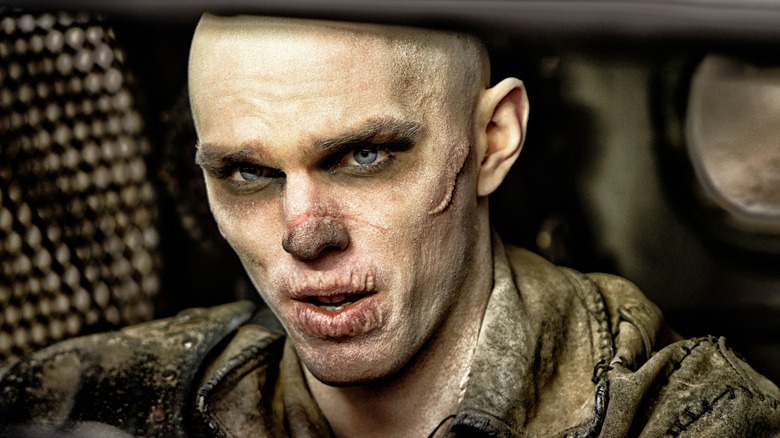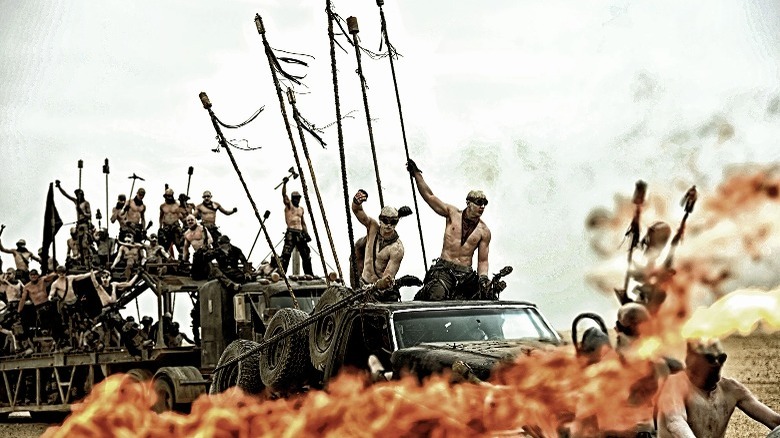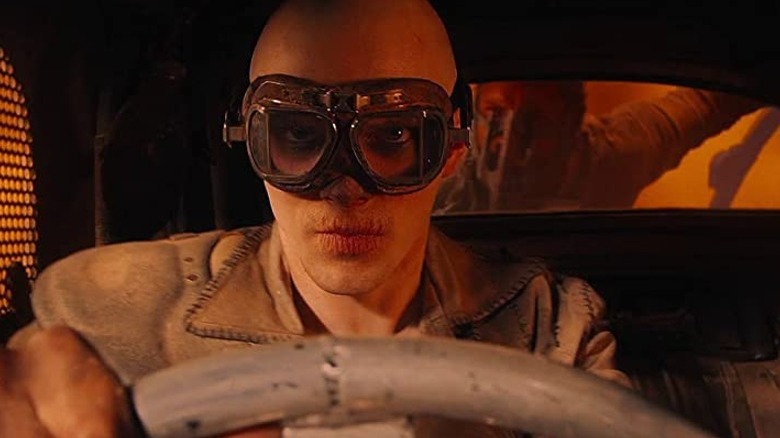
George Miller's "Mad Max: Fury Road" is a beast of a film. A lot of time and relentless effort went into the creation of this bonkers action spectacle, where Miller worked closely with comic-book artist Brendan McCarthy and Nico Lathouris (who appeared in Miller's 1979 original) to bring his vision to life. "Fury Road" presents a story of epic proportions — we are introduced smack dab in the middle of a dystopia, where cult-run city-states are surrounded by barren wastelands and survival is the name of the game. Once Max (Tom Hardy) arrives on the scene, he is quickly intercepted by a group of War Boys, who scream and lug him around to The Citadel with the intention of using his blood for medicinal purposes.
One of the most thrilling aspects of "Fury Road" is that it does not waste any time to set things up, or linger around for audiences to acquaint themselves with its chaotic, bizarre world. We're introduced to Imperator Furiosa (Charlize Theron) and ruler of the desert kingdom Immortan Joe from the get-go, diving right into the heart of rivalry and rebellion as Furiosa frees Joe's five wives from captivity. The world-building occurs at breakneck speed, and a lot is conveyed through visual symbolism alone, such as the startling attention to detail in the split-second shrine scene, which houses steering wheels adorned with a variety of objects.
Several visual details contribute to the overall look and feel of the War Boys, who act as paramilitary forces for The Citadel and are indoctrinated to become fanatical devotees to V8 since a formative age. Even in the aesthetically distinct world of "Fury Road," the face paint that the War Boys wear stands out, and Miller explains that it has a deeper, more meaningful purpose than being an aesthetic choice.
Half-lives

In a conversation with Sydney Opera House about the film's thrilling, arduous journey to the big screen, Miller went into considerable detail about the reason behind the War Boys covering their faces, arms, and torsos in white powder. While this power is also used as medication by Immortan Joe and this ritualistic display is, in part, in reverence to him, Miller revealed that the paint marks them as beings who are on the verge of dying soon, due to some illness:
"...The War Boys have some sort of neoplasm, some sort of disease going on so they're designated half-lives, so they're gonna put all of their effort into dying into some warrior afterlife. So they already are fashioning themselves like skeletons. They don't tattoo themselves with living objects, they tattoo or scarify themselves with car parts because car parts outlast them. And so if you're a War Boy or a half-life, you'll paint yourself white and form some sort of skeletal look."
This also explains the grey clay pigment around their eyes and mouths, as it grants a more gaunt, emaciated appearance, much like a skeleton. In stark contrast, Imperators like Furiosa do not adorn themselves with white paint, but with black on their usually shaved heads. This is because they are full lives, and they need to mark themselves with white the moment they fall ill. Miller also explained that "Max is a full-life ... And no one really picked it up," while stating that "people are reading a lot of iceberg under the tip," just as McCarthy had intended. This adds more layers to the fanatical devotion that the War Boys display, along with their relationship with death and what little choice they truly have when it comes to their actions, and their legacy.
The Ultimate Self-Sacrifice

The scarification process adds another layer to the psychology of the War Boys — they view cars as strong, sustainable machines that will outlive their legacy, which leads them to tattoo or adorn themselves with car parts. Raised as adept mechanics who know cars in and out, cars are the only things the War Boys can fix, as they cannot fix themselves or do anything to prolong their already limited lifespans. Moreover, their indoctrination into the cult makes them completely devoted to Immortan Joe's cause, leading death to evolve into an honorable ascension stage of sorts, instead of something to be feared.
This brings us to Nux (Nicolas Hoult), an impulsive War Boy who initially views Max as a blood bag, and the fact that he's accelerating toward death does not help alter his entrenched worldview. The silver chrome spray paint that he uses to mark his mouth doubles as a euphoric drug that will help numb his inevitable death. However, Nux undergoes a tremendous change of heart after Angharad's death, and his guilty conscience spurs him to change alliances when it matters the most. In the end, he sacrifices himself to save everyone — this time, Nux is ready to embrace death not for the promise of an afterlife, but because he wants to save his allies. "Witness me," he says, right before swerving into the canyon.
"Mad Max: Fury Road" is still packed with unexplained lore, which only enhances its appeal as a wild dystopian action offering like no other. This world, both barren and exhilarating, demands in-depth introspection and theorizing from its viewers and earns this from start to finish. Never has an apocalyptic world set in a drab, lifeless desert been this rich and thematically layered.
Read this next: The 14 Greatest Action Movies Of The 21st Century
The post The Face Paint In Mad Max: Fury Road Tells Its Own Hidden Story appeared first on /Film.
0 Comments